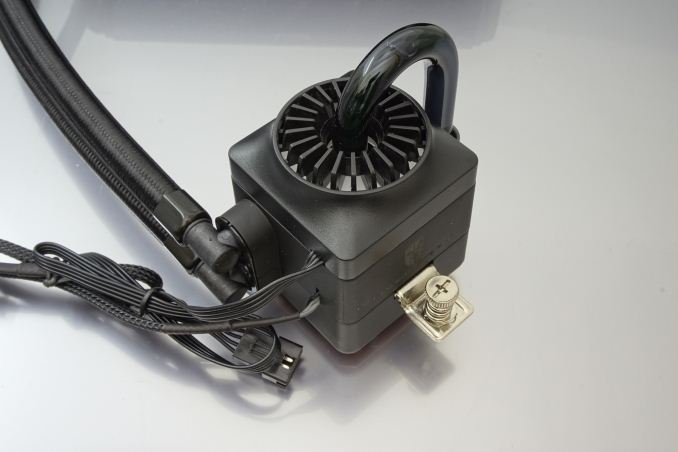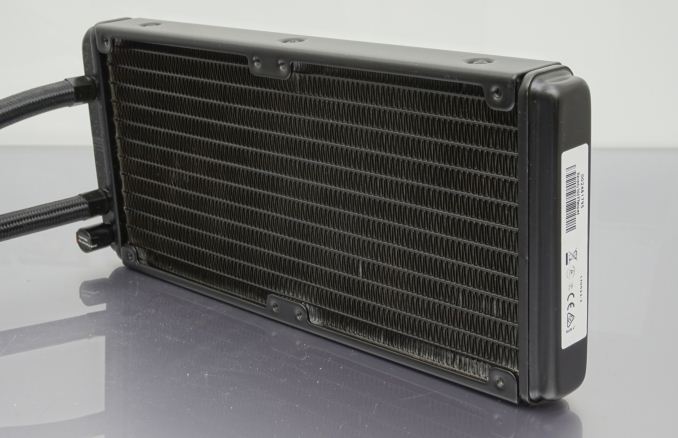The DeepCool Captain 240 EX RGB AIO Cooler Review: Pump it Up, Without the Noise
by E. Fylladitakis on December 14, 2017 9:00 AM EST- Posted in
- Cases/Cooling/PSUs
- AIO
- Deepcool
- Cooler
Conclusion
DEEPCOOL obviously wanted to keep things simple and risks low with the release of the Captain EX 240 RGB. They simply took the core design of their former all-in-one cooler, the Captain EX 240, and added RGB lighting to it. The Captain EX 240 was a commercially successful product, with good ratings and proven performance. Adding RGB lighting to it should have been a trivial matter for DEEPCOOL’s engineers and the production of the new model would not require any significant production line modifications, allowing the company to quickly market a competitively priced cooler with RGB lighting.
The stock thermal performance of the DEEPCOOL Captain EX 240 RGB is average. The Captain EX 240 RGB actually falls behind most of the similarly sized AIO coolers that we have tested to this date. DEEPCOOL’s unique fans do not seem to help with the cooler’s thermal performance either, as the thin radiator has low-to-medium airflow impedance and limited dissipation surface. Only significantly higher airflow fans would be able to make an actual difference here.
On the other hand, DEEPCOOL’s engineers designed the TF120 fans to be quiet, and quiet they are. That makes the Captain EX 240 RGB one of the quietest dual-fan AIO coolers in our database. Many competitive products that offer better thermal performance than the Captain EX 240 RGB also are much louder. The only (similarly sized) direct competitors of the Captain EX 240 RGB in terms of silent operation are the Fractal Design Celsius S24 and the Alphacool Eisbaer 240, which lack RGB lighting and/or retail at a significantly higher price.
The highlight of the DEEPCOOL Captain EX 240 RGB is neither its thermal performance or the quiet operation, but its design. The Captain EX 240 RGB implements the same “external circulation” design that made its predecessor famous, which is a nothing more than a short glass tube attached on the CPU block assembly. It is just an aesthetic upgrade that has no practical purpose, yet it was enough to improve the popularity of the Captain EX 240. The unique feature of the Captain EX 240 RGB is the addition of RGB lighting, which may be a double-edged knife for some users. The operation of the RGB LEDs requires a controller and, if the motherboard does not have RGB strip header(s), the controller that DEEPCOOL provides is very basic and requires opening up the case every time you want to change a setting/color. Users that like very clean designs would probably prefer to purchase the Captain EX 240 over its RGB variant, sacrificing the RGB lighting for fewer cables and gizmos to hide. Finally, the rubber tubing perhaps is a bit too thick and inflexible, but it definitely is very tough, and its exterior layer has it looking much like a high-pressure braided hose.
The current retail price of the DEEPCOOL Captain EX 240 RGB is $120 including shipping, placing it dangerously close to other products that may be lacking the RGB lighting but offer better overall performance. The vanilla Captain EX 240 retails for $90 and is virtually the same cooler, minus the RGB lighting and the extra RGB strip. For people who value quiet operation over raw thermal performance and want a quality product, either version of the Captain EX 240 is a sensible choice and may even be quite the bargain during a sale. Whether the addition of RGB lighting is worth the extra $30, we leave this decision to you.












34 Comments
View All Comments
croc - Friday, December 15, 2017 - link
I have an NHD-15 heat sink and I also have a corsair h80i v2. (my case, a silverstone FT1 does not easily support radiators larget than 120mm) My CPU is an older 3930K six core that warms up nicely... Of course I do not have all the nice test bench stuff that Anandtech has, so my results are quite a bit more touchy-feely. By just a whisker the NHD-15 is both a tad quieter and a tad cooler.... I also like the fact that I know that outside of the fans there are no moving parts to fail.I am sure that my limitations are the 120 mm radiator, and I am also pretty well convinced that within a given sized radiator, there will be a very narrow range of test results across the range of AIO kits. But I keep looking...
LordanSS - Friday, December 15, 2017 - link
Thank you, Mr. Fylladitakis for your review.Since the advent of AIO liquid cooling kits my personal builds have changed a good bit. Have a H100i on my main build for a few years now, and my old and trusty second machine has a Hyper 212 EVO on it.
I've had bad experiences with heavy air coolers in the past, so I tend to stay away from them these days. My cases have positive pressure and the H100i works well as an exhaust mounted at the top.
To each their own. I know several people that frequent this website are still fond of air cooling, and in many situations it's still a very good and efficient option but in the end I'd say it depends on what kind of build you have in mind.
snarfbot - Sunday, December 17, 2017 - link
how long are these coolers being run at load?deadlockedworld - Wednesday, April 11, 2018 - link
For all the commentary about the bench -- this deepcool is not in the Anandtech bench section. ...